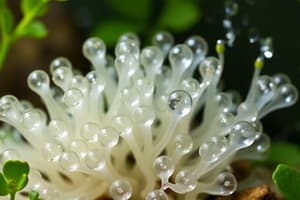Podcast
Questions and Answers
What is the primary function of autotrophic nutrition in plants?
What is the primary function of autotrophic nutrition in plants?
- To absorb water and carbon dioxide
- To release oxygen into the atmosphere
- To break down organic molecules into energy
- To synthesize their own food from inorganic substances (correct)
What is the name of the process by which light energy is absorbed and converted into chemical energy?
What is the name of the process by which light energy is absorbed and converted into chemical energy?
- Reduction
- Regeneration
- Carbon Fixation
- Photosynthesis (correct)
What is the role of RuBP in the Calvin cycle?
What is the role of RuBP in the Calvin cycle?
- To initiate the Calvin cycle (correct)
- To release oxygen as a byproduct
- To regenerate G3P
- To fix CO2 into a 3-carbon molecule
What is the byproduct of photosynthesis?
What is the byproduct of photosynthesis?
What type of autotrophic nutrition uses chemical energy to synthesize food?
What type of autotrophic nutrition uses chemical energy to synthesize food?
What is the importance of autotrophic plants in an ecosystem?
What is the importance of autotrophic plants in an ecosystem?
Flashcards are hidden until you start studying
Study Notes
Autotrophic Nutrition
Definition Autotrophic nutrition is a process in which plants, algae, and some bacteria produce their own food from inorganic substances.
Characteristics
- Plants have the ability to synthesize their own food using light energy from the sun.
- They use carbon dioxide and water as raw materials.
- Oxygen is released as a byproduct of photosynthesis.
Mechanism of Autotrophic Nutrition
- Photosynthesis: Light energy is absorbed by pigments such as chlorophyll and converted into chemical energy.
- Carbon Fixation: CO2 is fixed into a 3-carbon molecule called 3-phosphoglycerate (3-PGA) via the Calvin cycle.
- Reduction: 3-PGA is reduced to form glyceraldehyde-3-phosphate (G3P) using energy from ATP and NADPH.
- Regeneration: G3P is used to regenerate RuBP, the 5-carbon molecule that initiates the Calvin cycle.
Importance of Autotrophic Nutrition
- Autotrophic plants are the primary producers of the ecosystem, providing energy and organic compounds for other living organisms.
- They play a crucial role in maintaining the balance of oxygen and carbon dioxide in the atmosphere.
Types of Autotrophic Nutrition
- Photoautotrophs: Plants, algae, and cyanobacteria that use light energy to synthesize food.
- Chemoautotrophs: Bacteria that use chemical energy to synthesize food, often in the absence of light.
Autotrophic Nutrition
- Autotrophic nutrition is the process by which plants, algae, and some bacteria produce their own food from inorganic substances.
Characteristics
- Plants have the ability to synthesize their own food using light energy from the sun.
- They use carbon dioxide and water as raw materials.
- Oxygen is released as a byproduct of photosynthesis.
Mechanism of Autotrophic Nutrition
- Light energy is absorbed by pigments such as chlorophyll and converted into chemical energy through photosynthesis.
- CO2 is fixed into a 3-carbon molecule called 3-phosphoglycerate (3-PGA) via the Calvin cycle.
- 3-PGA is reduced to form glyceraldehyde-3-phosphate (G3P) using energy from ATP and NADPH.
- G3P is used to regenerate RuBP, the 5-carbon molecule that initiates the Calvin cycle.
Importance of Autotrophic Nutrition
- Autotrophic plants are the primary producers of the ecosystem, providing energy and organic compounds for other living organisms.
- They play a crucial role in maintaining the balance of oxygen and carbon dioxide in the atmosphere.
Types of Autotrophic Nutrition
- Photoautotrophs: Plants, algae, and cyanobacteria that use light energy to synthesize food.
- Chemoautotrophs: Bacteria that use chemical energy to synthesize food, often in the absence of light.
Studying That Suits You
Use AI to generate personalized quizzes and flashcards to suit your learning preferences.




